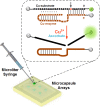Rapid Quantitative Fluorescence Detection of Copper Ions with Disposable Microcapsule Arrays Utilizing Functional Nucleic Acid Strategy
- PMID: 30631123
- PMCID: PMC6328549
- DOI: 10.1038/s41598-018-36842-x
Rapid Quantitative Fluorescence Detection of Copper Ions with Disposable Microcapsule Arrays Utilizing Functional Nucleic Acid Strategy
Abstract
In this work, an economical and easy-to-use microcapsule array fabricated by ice printing technique has been realized for ultrasensitive fluorescence quantification of copper ions employing functional nucleic acid strategy. With ice printing, the detection reagents are sealed by polystyrene (PS) film isolation and photopolymer, which guarantees a stable and contamination-free environment for functional nucleic acid reaction. Our microcapsule arrays have shown long-term stability (20 days) under -20 °C storage in frozen form before use. During the Cu2+ on-site detection, 1 μL sample is simply injected into the thawy microcapsule by a microliter syringe under room temperature, and after 20 minutes the fluorescence result can be obtained by an LED transilluminator. This method can realize the detection limit to 100 nM (100 fmol/μL) with high specificity.
Conflict of interest statement
The authors declare no competing interests.
Figures






References
-
- Mayer G. AngewandteChemie Int. Ed. 2009. The chemical biology of aptamers; pp. 2672–2689. - PubMed
Publication types
MeSH terms
Substances
Grants and funding
- 21575005/National Natural Science Foundation of China (National Science Foundation of China)/International
- 21275009/National Natural Science Foundation of China (National Science Foundation of China)/International
- 21675004/National Natural Science Foundation of China (National Science Foundation of China)/International
- 21575005/National Natural Science Foundation of China (National Science Foundation of China)/International
- 21275009/National Natural Science Foundation of China (National Science Foundation of China)/International
- 21675004/National Natural Science Foundation of China (National Science Foundation of China)/International
- 21675004/National Natural Science Foundation of China (National Science Foundation of China)/International
- 21575005/National Natural Science Foundation of China (National Science Foundation of China)/International
- 21275009/National Natural Science Foundation of China (National Science Foundation of China)/International
LinkOut - more resources
Full Text Sources

